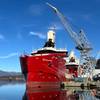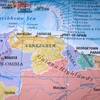Unmanned Aircraft to Take Off from Falkor
Research vessel Falkor leaves Darwin today to explore the poorly understood air-sea interactions across the Indian and Pacific Ocean. This research is very important in understanding the ocean’s role in global climate change. The exchange of energy and matter between the atmosphere and the ocean are particularly onerous requirements, and have largely been neglected in climate research. Chief Scientist Dr. Oliver Wurl, from the University of Oldenburg and his international team of scientists from Germany, the United States, and United Kingdom plan to gain new insight during this 31-day expedition.
The team of sea surface experts and marine geochemists on the expedition will use newly developed technologies to closely examine the ocean’s role in exchange processes. A variety of unique tools will be used including unmanned aircraft and a remote controlled kayak. The unmanned aircraft with a wingspan of 3.6 meters will take off from research vessel Falkor to scan the sea surface with cameras and highly sensitive thermal and optical measuring instruments. The aircraft can remain in the air between four and six hours tracking hundreds of kilometers, with different sensors.
"These unmanned aircraft are unique as they have never been used for research purposes on a ship – we are excited about the first application of this work," said Chief Scientist Oliver Wurl.
The research team will also be deploying a remote controlled catamaran or kayak developed by the Institute for Chemistry and Biology of the Marine Environment at the University of Oldenburg. The kayak will scan the sea surface with the latest sensors and take samples which will later be analyzed in the laboratory on Falkor. In addition to the aircraft and kayak, the scientists will use autonomous buoys to measure gas exchange processes between ocean and atmosphere. With the aid of the buoy, the change of carbon dioxide (CO2) over a period of 20 minutes can be recorded. The aim is to describe the absorption of greenhouse gases through the surface of the ocean better.
"The use of remotely piloted aircraft, autonomous measuring buoys and research catamaran have great potential for new discoveries," said Wurl. "Even though the ocean seems readily available, exploring the extremely thin layer that rests between the ocean and the atmosphere is technologically challenging."
Follow the scientists over the next 31 days as they embark on their adventure. Daily blogs and weekly video updates will be available here.
The team will also connect with classrooms across the world on October 19th as they share about the science and careers at sea through a live Google Hangout with Earth Echo International.
Schmidt Ocean Institute was created by Eric and Wendy Schmidt in 2009 to enable research that expands understanding of the world’s ocean using advanced technology, intelligent observation, and the open sharing of information. Annually the organization invites select scientific teams from around the world to carry out collaborative oceanographic research and technology development aboard its 272-foot research vessel, Falkor, launched in 2012.
Latest 3D image processed by John Greene showing a large seamount on Tamu Massif. Photo credit- John Greene















